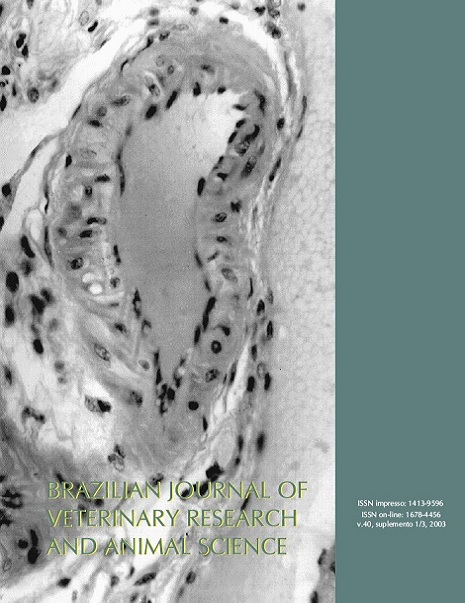In vitro susceptibility to antibiotics in Staphylococcus spp e Micrococcus spp strains isolated from oral mucosae of captive capuchin monkeys (Cebus apella)
DOI:
https://doi.org/10.1590/S1413-95962003000800001Keywords:
Oral swabs, Staphylococcus spp, Micrococcus spp, Antibiotics, in vitro susceptibility, Capuchin monkeys (Cebus apella)Abstract
Twenty-nine capuchin monkeys (Cebus apella) were used in this study. Fifty samples of oral mucous membrane were collected in area next to their muco-gingival-maxilar transition using sterilized swabs soaked in Brain Heart Infusion (BHI). All animals were clinically examined for periodontal evaluation. The samples were cultivated in appropriate media, namely: simple broth, BHI broth and, blood agar in order to get aerobic Gram positive cocos, from the Micrococcaceae family, isolated. Catalase test, Staphy-test (a quick-test for Staphylococcus aureus characterization) and bactracin-sensitivity test were the tools employed for their classification. Data were follows: 73.1% of them were Staphylococcus spp; 15.4% Staphylococcus aureus; and, 11.5% Micrococcus spp. The isolated were strains tested for their in vitro susceptible to antibiotics by the agar diffusion technique. Concerning the Staphylococcus spp strains, 94.7% were susceptibility to cephalotin; however, 89.5% of them were resistant to penicillin; 97.4% to oxacilin; 55.3% to tetracicline; 57.9% to clindamicine; and 63.2% to amoxiciline. Staphylococcus spp strains studied presented the highest in vitro sensitivity degree to cephalotin.Downloads
Download data is not yet available.
Downloads
Published
2003-01-01
Issue
Section
UNDEFINIED
License
The journal content is authorized under the Creative Commons BY-NC-SA license (summary of the license: https://
How to Cite
1.
Aspis D, Baldassi L, Germano PML, Fedullo JDL, Passos E de C, Gonçalves M de A. In vitro susceptibility to antibiotics in Staphylococcus spp e Micrococcus spp strains isolated from oral mucosae of captive capuchin monkeys (Cebus apella). Braz. J. Vet. Res. Anim. Sci. [Internet]. 2003 Jan. 1 [cited 2024 Apr. 18];40(supl.):83-9. Available from: https://www.revistas.usp.br/bjvras/article/view/11424





